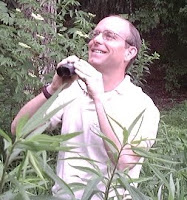The Nature of DuPage: Neighborhood singing insects

(POSTED: 8/16/10) We have reached the time of year when the birds have gone largely quiet, and the dominant wildlife sounds are produced by insects. In a typical residential neighborhood you can expect to hear around 15 species of crickets, katydids and cicadas in late summer to early autumn.
Loudest are the cicadas, which sing from morning to late dusk. Four species are common in the Chicago area. They look much alike, but have distinct songs. The dog day cicada produces a siren-like clear, high-pitched tone. A fast-pulsing, buzz-saw-like song characterizes the lyric cicada, which can produce very loud morning choruses along the Des Plaines River but occurs in smaller numbers even in neighborhoods remote from water. Linne's cicada has a slower pulsed song, its vibrato commonly at around 4-6 pulses per second. Still slower is the scissor grinder, whose "ee-oowee-oowee" song often dominates the insect song chorus at dusk. Representatives of all four of these cicada species emerge each year, though the nymphs require several years of underground root sap feeding to mature.
As the light fades, cicadas give way to katydids and crickets. Over the years the sound I have been asked to identify most often is the common true katydid's loud "eh-eh!" The song's rasping notes most commonly are grouped in twos, though I have heard threes and even four-syllable songs in different DuPage County populations. Songs are separated by about a second in warm weather. These flightless insects are a good two inches long and generally stay well up in trees. Like most other katydids they are green and resemble leaves with legs.
Another familiar nighttime sound in our area is the rapid, stopwatch-like ticking of the greater angle-winged katydid. Later in the season these tree dwellers occasionally sing in the daytime.
The remaining singing insects common to residential neighborhoods in our area all are crickets. Some are distinctive, like the friendly chirping of the fall field cricket, with its black, inch-long body and ground-dwelling habit. The snowy tree cricket produces evenly spaced clear tones that vary with temperature, speeding up when it's warm and slowing as the temperature drops. The snowy's song is the one you most often hear in the mood-setting ambient background soundtracks of nighttime scenes in movies.
The remaining cricket songs seem to blend together to form an undifferentiated background wall of sound. With study and practice you may learn to distinguish the trills and chirps of three kinds of ground crickets, a bush cricket, a trig and three additional tree crickets that frequent our neighborhoods. The resource I recommend for those who wish to explore this topic further is The Songs of Insects by Elliot and Hershberger. The book includes beautiful photos of all the species I have mentioned as well as a CD with recordings of their songs.
By Carl Strang, who has been an interpretive naturalist for the Forest Preserve District of DuPage County for more than 28 years. He holds a Ph.D. in wildlife ecology from Purdue University. Carl has won awards from the Illinois Wildlife Federation and from the National Association for Interpretation. He is the author of the book, Interpretive Undercurrents, on the art of natural history interpretation. His weekly radio spot, "Wild Things," is broadcast from the College of DuPage radio station (WDCB, 90.9FM) on Monday evenings between 6:00 and 6:30. Current research interests include distribution and ecology of singing insects, and winter movement patterns and social structure of Canada geese.
0 comments: